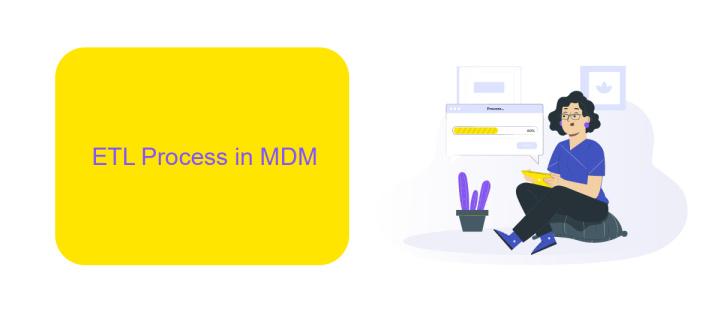Master Data Management ETL
Master Data Management (MDM) and Extract, Transform, Load (ETL) are critical components in modern data management strategies. MDM ensures the consistency, accuracy, and accountability of a company's key data assets, while ETL processes facilitate the efficient movement and transformation of data across systems. Together, they enable organizations to maintain high-quality data, driving better decision-making and operational efficiency.
Introduction
Master Data Management (MDM) is a crucial aspect of modern business operations, ensuring that an organization's critical data is accurate, consistent, and accessible. ETL (Extract, Transform, Load) processes play a vital role in MDM by facilitating the seamless integration and transformation of data from various sources into a unified repository.
- Extraction: Gathering data from diverse sources.
- Transformation: Converting data into a consistent format.
- Loading: Importing data into a centralized system.
Effective MDM and ETL processes enable businesses to maintain data integrity and improve decision-making. Tools like ApiX-Drive can significantly enhance these processes by automating data integration and ensuring real-time synchronization across different platforms. This not only saves time but also minimizes errors, allowing businesses to focus on leveraging their data for strategic advantages.
ETL Process in MDM

The ETL (Extract, Transform, Load) process in Master Data Management (MDM) is crucial for ensuring that data from various sources is accurately integrated and maintained. During the extraction phase, data is collected from multiple systems, including databases, applications, and external sources. This data is then transformed to meet the specific requirements of the MDM system, which may involve cleansing, validating, and standardizing the information to ensure consistency and accuracy across the organization.
Once the data is transformed, it is loaded into the MDM repository where it can be managed and utilized effectively. Integration services like ApiX-Drive can significantly streamline this process by automating data transfers and ensuring seamless connectivity between different systems. ApiX-Drive offers tools to configure integrations without the need for extensive coding, making it easier to maintain up-to-date and reliable master data. This not only enhances data quality but also improves decision-making and operational efficiency within the organization.
Data Extraction and Cleansing

Data extraction and cleansing are critical steps in the Master Data Management (MDM) ETL process. These steps ensure that the data collected from various sources is accurate, consistent, and ready for integration into the MDM system. Proper extraction and cleansing help in maintaining data quality and reliability, which are essential for making informed business decisions.
- Identify data sources: Determine the databases, applications, or files from which data needs to be extracted.
- Extract data: Use ETL tools or services like ApiX-Drive to automate the extraction process from multiple sources.
- Cleanse data: Remove duplicates, correct errors, and standardize formats to ensure data consistency.
- Validate data: Verify the accuracy and completeness of the cleansed data before loading it into the MDM system.
Using a service like ApiX-Drive can streamline the integration and automation of data extraction from various sources, reducing manual efforts and minimizing errors. This ensures that the data entering the MDM system is of high quality, ultimately leading to better data governance and more reliable business insights.
Data Transformation and Mapping

Data transformation and mapping are crucial steps in the Master Data Management (MDM) ETL process. These steps ensure that data from various sources is converted into a consistent, usable format. Transformation involves cleaning, enriching, and structuring the data, while mapping aligns this transformed data with the target schema.
Effective data transformation can significantly improve data quality and usability. This process often includes data normalization, deduplication, and validation. By implementing these steps, organizations can ensure that the data is accurate, complete, and reliable.
- Normalization: Standardizing data formats across different sources.
- Deduplication: Removing duplicate entries to maintain a single source of truth.
- Validation: Ensuring data meets predefined quality standards.
Tools like ApiX-Drive can simplify the integration and transformation processes. ApiX-Drive allows for seamless data transfer between various systems, automating much of the transformation and mapping work. This ensures that the data is consistently accurate and readily available for decision-making processes.
- Automate the work of an online store or landing
- Empower through integration
- Don't spend money on programmers and integrators
- Save time by automating routine tasks
Data Loading and Validation
Data loading in Master Data Management (MDM) involves transferring cleaned and transformed data into the target repository. This step is crucial for ensuring that the data is available for analysis and reporting. Efficient data loading processes are essential for maintaining data integrity and consistency. Tools like ApiX-Drive can be leveraged to automate and streamline this process, facilitating seamless integration between various data sources and the MDM system. ApiX-Drive's user-friendly interface and robust capabilities make it an excellent choice for managing data flows and ensuring timely updates.
Validation is another critical aspect of data loading. It involves verifying that the data meets predefined quality standards before it is stored in the MDM system. This step helps in identifying and rectifying errors, ensuring data accuracy and reliability. Validation rules can be implemented to check for data completeness, consistency, and conformity to business rules. Using automated tools like ApiX-Drive can enhance the validation process by providing real-time checks and alerts, thus ensuring that only high-quality data is loaded into the system. This not only improves data trustworthiness but also enhances overall decision-making processes.
FAQ
What is Master Data Management (MDM) and why is it important?
What is ETL and how does it relate to MDM?
How can I automate the ETL process for MDM?
What challenges might I face when implementing MDM with ETL?
How do I ensure data quality in an MDM system?
Time is the most valuable resource in today's business realities. By eliminating the routine from work processes, you will get more opportunities to implement the most daring plans and ideas. Choose – you can continue to waste time, money and nerves on inefficient solutions, or you can use ApiX-Drive, automating work processes and achieving results with minimal investment of money, effort and human resources.


